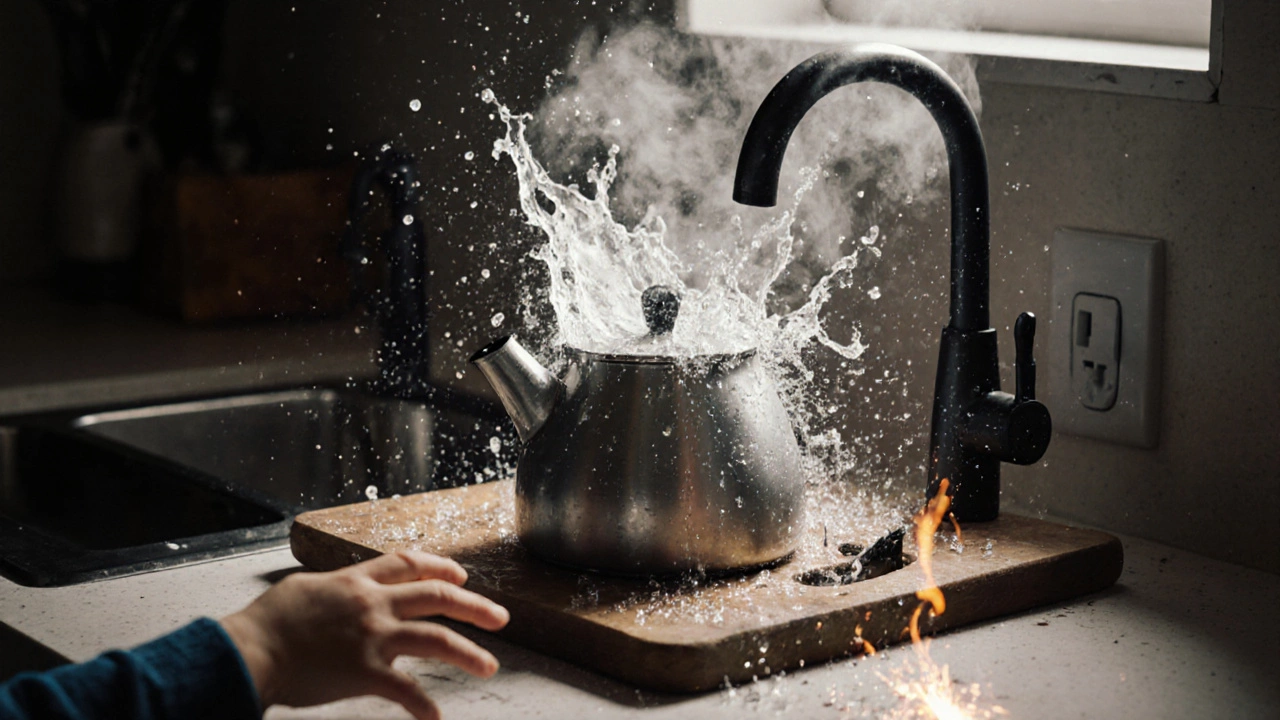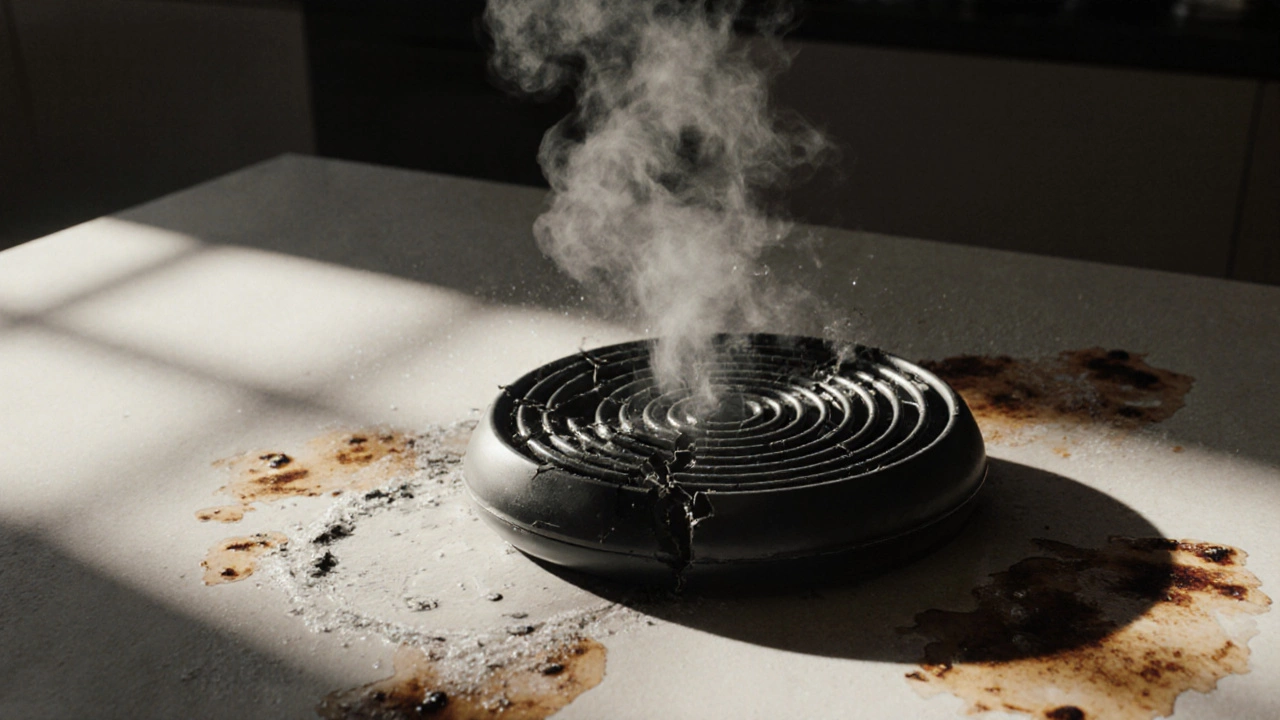Electric Kettle Safety Quiz
How well do you know the safety rules for electric kettles? This quiz will help you identify potential hazards in your usage habits. Answer 5 questions to see your score and learn about common mistakes people make with electric kettles.
What's the #1 mistake people make with electric kettles?
Can you safely boil milk directly in an electric kettle?
How often should you descale your electric kettle if you live in a hard water area like Vancouver?
What should you do if you hear a dry crackling sound from your electric kettle?
Why shouldn't you use abrasive scrubbers to clean your electric kettle?
Most people think an electric kettle is just a simple machine: fill it, press a button, wait for the whistle. But if you treat it like a basic pot, you could end up with a broken appliance, a scalding accident, or even a fire. Electric kettles are smarter than they look-and they come with hidden rules you can’t ignore.
Don’t boil it empty
Boiling an electric kettle without water is the #1 mistake people make. It doesn’t take long for the heating element to overheat. Most modern kettles have auto-shutoff, but that’s not a guarantee. Older models or cheap ones might not shut off at all. Even if it does, the element can still get hot enough to warp, crack, or burn out. Replacing the element costs almost as much as a new kettle. And if the plastic base melts? You’re out a whole appliance.
I’ve seen kettles with blackened bases and melted plastic from someone who walked away to answer the door. Five minutes without water is enough. If you hear a dry crackling sound or smell burning plastic, unplug it immediately. No second chances.
Never use it for anything other than water
Some people try to make tea directly in the kettle, or even heat milk, soup, or coffee grounds in it. Don’t. Electric kettles are designed for water only. Milk leaves a sticky residue that burns onto the heating element. That residue builds up over time, creating a fire hazard and giving every future brew a rancid taste. Coffee grounds clog the spout and filter. Soups and broths leave mineral deposits that corrode the interior.
Even adding sugar or lemon slices while boiling can cause crystallization on the element. That’s not just messy-it reduces efficiency. Your kettle will take longer to boil, use more electricity, and wear out faster. Use a separate mug or pot for anything that’s not plain water.
Avoid hard water without descaling
If you live in Vancouver, you know our water isn’t soft. Hard water leaves behind white, chalky limescale. It’s not just ugly-it’s dangerous. Scale acts like insulation around the heating element. That means the element has to work harder, get hotter, and burn out sooner. A heavily scaled kettle can overheat and shut down permanently.
Descaling isn’t optional. Do it every month if you use the kettle daily. Mix equal parts white vinegar and water, fill the kettle halfway, bring it to a boil, then let it sit for 30 minutes. Pour it out, rinse twice with clean water, then boil a full kettle of fresh water and discard that too. Skip this, and your kettle’s lifespan drops from 5 years to 18 months.
Don’t overfill it
Every kettle has a maximum fill line. Ignore it at your own risk. Overfilling causes water to splash out during boiling, especially when the steam pressure builds. Hot water spraying out of the spout can burn your hands, face, or clothes. Worse, if water gets into the base or electrical connections, you risk a short circuit or electrocution.
Some people think, “It’s just a little extra,” but even 10% over the line can cause problems. The steam vent isn’t designed to handle excess pressure. The lid might pop open unexpectedly. I’ve seen kettles with scorched countertops from a single overfill accident. Always fill to the line-or below it.

Never leave it unattended while boiling
It’s tempting. You’re making tea, you’ve got kids to pick up, a call coming in, or you just want to check your phone. But a boiling kettle is not like a coffee maker. It’s a high-heat device with pressurized steam. If the auto-shutoff fails-or if you’ve got a faulty model-it can keep boiling until the water runs out. That’s when the danger spikes.
Even if your kettle has a reliable shutoff, things can go wrong. A child might bump it. A pet might knock it over. A power surge could trigger a glitch. Always stay in the same room. If you need to leave, turn it off. Better yet, wait until you’re ready to pour before you turn it on.
Avoid using it on an unstable surface
Don’t place your kettle on the edge of the counter, near the sink, or on a wobbly table. A sudden bump, a slip of the hand, or even a cat jumping onto the counter can send it tipping. Boiling water spills instantly. The damage isn’t just to your floor or furniture-it’s to your skin. Severe burns from boiling water require medical attention.
Always place the kettle on a flat, dry, heat-resistant surface. Keep it away from the edge. Make sure the power cord doesn’t dangle where someone could trip on it. I’ve seen people use kettles on microwave stands or cutting boards. Those aren’t stable. Use the counter. Use the designated spot. Simple.
Don’t clean it with abrasive scrubbers
That stainless steel interior looks tough, but it’s not invincible. Using steel wool, harsh scouring pads, or abrasive cleaners scratches the surface. Those scratches trap minerals and bacteria. Over time, they become hard to clean and can affect the taste of your water. More importantly, scratches can compromise the kettle’s protective coating, leading to rust or metal leaching into your drink.
Use a soft sponge, a non-abrasive cleaner, or just vinegar and water. For the outside, a damp cloth with mild dish soap is enough. Never spray cleaner directly into the spout or base. Always unplug it before cleaning. And never put it in the dishwasher-most kettles aren’t designed for it, even if the box says “dishwasher safe.” That label often refers to the removable parts, not the whole unit.

Don’t ignore the warning signs
Your kettle talks to you. You just have to listen. If it starts taking longer to boil, making strange noises, leaking from the base, or emitting a burning smell, it’s not just “getting old.” It’s failing. Continuing to use it is risky.
Here’s what to watch for:
- Delayed boiling times (even after descaling)
- Sparking or flickering lights near the base
- Water leaking from the bottom or sides
- A persistent plastic or metallic taste in the water
- The auto-shutoff doesn’t engage
If any of these happen, stop using it. Don’t try to “fix” it with tape or a new cord. Electric kettles aren’t repairable by users. Replace it. A new one costs less than a hospital visit from a burn.
Don’t assume all kettles are the same
Just because two kettles look alike doesn’t mean they work the same. A $15 model from a discount store might not have thermal protection, a cool-touch handle, or a reliable auto-shutoff. A $60 model from a trusted brand likely does. The difference isn’t just in features-it’s in safety.
Look for certifications: UL, CSA, or CE marks. These mean the kettle passed independent safety tests. Avoid no-name brands with no safety ratings. If the packaging says “not for commercial use,” that’s a hint it’s not built for daily home use either.
Also, don’t buy a kettle just because it’s trendy. Glass bodies look nice but are fragile. Plastic bases can melt. Metal exteriors get hot. Choose based on safety, not style.
What to do instead
Here’s the simple truth: treat your electric kettle like a tool, not a toy. Fill it to the line. Use only water. Descaling every month. Keep it on a stable surface. Stay nearby while it’s on. Clean it gently. Replace it when it shows signs of wear.
Do that, and your kettle will last 5-7 years without a single accident. Skip these rules, and you’re gambling with your safety-and your wallet.
Can I boil milk in my electric kettle?
No. Boiling milk in an electric kettle leaves a sticky residue on the heating element that burns and hardens over time. This creates a fire risk, ruins the taste of future brews, and damages the kettle. Always heat milk in a separate pot on the stove.
How often should I descale my electric kettle?
If you use your kettle daily and live in a hard water area like Vancouver, descale it every month. Use a 50/50 mix of white vinegar and water, boil it, let it sit for 30 minutes, then rinse thoroughly with fresh water. Skipping descaling cuts your kettle’s lifespan in half.
Is it safe to leave the kettle plugged in when not in use?
It’s not dangerous in the short term, but it’s unnecessary. Unplugging your kettle when not in use reduces standby power use and eliminates any risk of electrical faults or accidental activation. It’s a simple habit that adds safety.
Why does my kettle make a loud noise when boiling?
Loud bubbling or rumbling is normal during boiling. But if you hear clicking, popping, or buzzing from the base, it could mean the heating element is failing or there’s a loose connection. Stop using it and replace the kettle. These sounds signal internal damage.
Can I use my electric kettle to make instant noodles?
No. Adding noodles, broth, or seasoning directly to the kettle contaminates the interior and leaves residue on the heating element. This affects performance, creates a fire hazard, and ruins the taste of future water. Always boil water in the kettle, then pour it into a separate bowl with your noodles.
What should I do if my kettle starts leaking?
Stop using it immediately. Leaking means the internal seals or tank are damaged. Water contacting electrical components can cause shocks or short circuits. Do not attempt to repair it yourself. Replace the kettle. Safety is more important than saving a few dollars.

